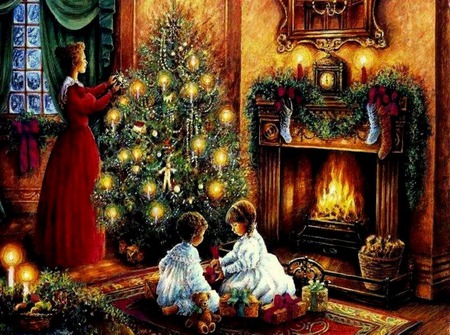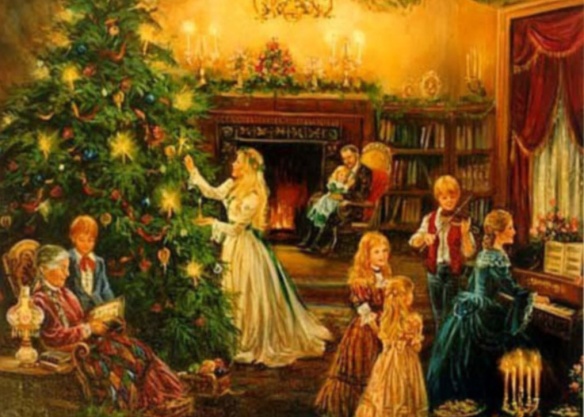 A winter festival has been celebrated since pagan times but it wasn’t until the Victorian era (1837-1901) that traditions that are associated with Christmas really took off and the season began to resemble modern-day Christmas.
A winter festival has been celebrated since pagan times but it wasn’t until the Victorian era (1837-1901) that traditions that are associated with Christmas really took off and the season began to resemble modern-day Christmas.
You may have thought that Christmas cards, Christmas crackers, turkey dinner with too much punch and opulent toy store displays were symbols of the commercialism that comes with today’s festive season, but they actually had their origins in Victorian times.
Christmas Cards
The Christmas card was born in 1843 when wealthy business man, Henry Cole, hired an artist to design a card for Christmas. The artist drew a family around the dining table and it contained a festive message. The cards were sold for an impressive one shilling each, putting them out of the reach of most ordinary people. The expense meant that children were encouraged to make their own, before mass printing techniques in the 1880’s brought the price down.
To make your own Victorian Christmas cards, just follow these simple steps:
1 Create lace effect paper using strips of ordinary plain paper and cut out a scalloped edge. You can do this via a template or draw your own.
2. Place a folded cloth under your paper to protect your table and then use a pin to make lots of tiny holes in your paper – this will give it the appearance of lace. If children are making the cards, please ensure you supervise them.
3. Stick your ‘lace’ paper along the edge of a piece of white card.
4. Stick a Victorian picture onto the front of your card – or if you want to have a go at recycling you could use pictures from last year’s cards or cut them out from leftover Victoriana gift wrap. Examples of the types of illustrations that adorned Victorian cards can be found from an original collection at the Library of Birmingham.
If you are unsure, you can also watch an instructional video by the BBC.
Christmas Crackers
In 1847, a confectioner called Tom Smith was looking for a new and inventive way to sell sweets with a bang. He had discovered the sugared almond ‘bon bon’ in France and wanted to make it more popular with his customers in Britain, so he began by wrapping the bon bons in paper tissue with a love moto. The idea for the cracker was inspired by the sound of a log crackling in the fireplace. Tom thought that to combine the wrapped sweets and motto with a crackle would make them more appealing for Christmas. He experimented with chemical compounds until he found one that made a bang when the paper was torn. The iconic cracker had arrived.
You can make your own crackers:
1. Take the cardboard inners of three small toilet rolls and measure out some tissue paper the same length as the cardboard rolls.
2. Place double sided tape along one edge of the tissue paper, roll up the toilet rolls and stick down.
3. Roll up a second sheet of paper tissue that is slightly shorter than the first sheet.
4. Tie a ribbon at the neck of your cracker and remove the end toilet roll, then place a cracker snap inside, with double sided tape at both ends to secure it to the tied end of the cracker.
5. Place sugared almonds and a love motto in your cracker and tie up the remaining open end with another ribbon, sticking down the second piece of tape on your snap.
6. You can decorate your crackers with bows, pieces of fabric or Victoriana images.
Turkey Dinner
Turkey was the meat of choice for upper class Victorians on Christmas day and it gradually replaced the more traditional choices of beef and goose, until by the start of the 20th century, it became the most popular seasonal dish. You could opt for goose if you want to try something both traditional and different.
Charles Dickens described a Christmas dinner of roast goose with sage and onions, gravy, mashed potatoes and apple sauce in his famous novel, ‘A Christmas Carol’. It’s really easy for you to have the same.
1. Preheat your oven to the temperature suggested for your goose.
2. Remove giblets and excess fat from the cavity – you can use this fat to spread over the goose to enhance the cooking.
3. Stuff the neck cavity with sage and onions – slice your own onions to add to the mix as this tastes far more superior than packet sage and onion.
4. Pierce the skin with a fork, add a small amount of salt and pepper and rub butter into it. Place on foil on a meat tin in the center of the oven. You will need around 2 hours, 45 minutes of cooking time for a 4.5kg goose.
5. Transfer to a serving dish and leave to stand for 20 minutes before you carve as this will retain more of the flavors.
6. Add home made mashed potatoes with butter and a spoonful of apple sauce.
Christmas Trees
Pagans used to decorate fir trees in their winter festivals but the traditional of the Christmas tree began when Prince Albert got one for Queen Victoria. The Illustrated London News published a drawing in 1848 of the prince and Queen and all their children surrounding an elaborate Christmas tree decorated with candles, home made decorations and sweets. After seeing the drawing, the public followed suit.
You can go traditional by choosing a real Christmas tree and decorating it with handmade paper ornaments and sweets you can hang from the branches. If you want to go all out, you could even try real candles.
1. Get clip candle holders so you can safely attach your real candle to your tree
2. Don’t place any other decorations above your real candles
3. Always light your candles from those at the top of the tree down, so you don’t accidentally set fire to your clothes
4. Make sure you count the number of candles you place on your tree and what position they are in
5. Have candle snuffs and a fire extinguisher in case of an emergency
6. Only have your candles lit for short periods of time and never leave your candles unattended
7. For a safer option, you could use LED tea lights in your clip on candle holder – while not strictly Victorian, LED’s are a no flame light.
Christmas Presents
Macy’s Department store in New York was one of the first to create a Christmas toy display in their window in 1897, the first time themed displays had been tried. However, as toys were handmade they were expensive and out of the reach of most parents so the average Victorian child received a stocking containing fruit, nuts and if they were lucky, sweets. You could try this by choosing a traditional knitted stocking (or knitting your own) and adding fruit and nut selections and some sugared bon bon’s. You might want to include some back up presents too and diffuse any Christmas drama.








